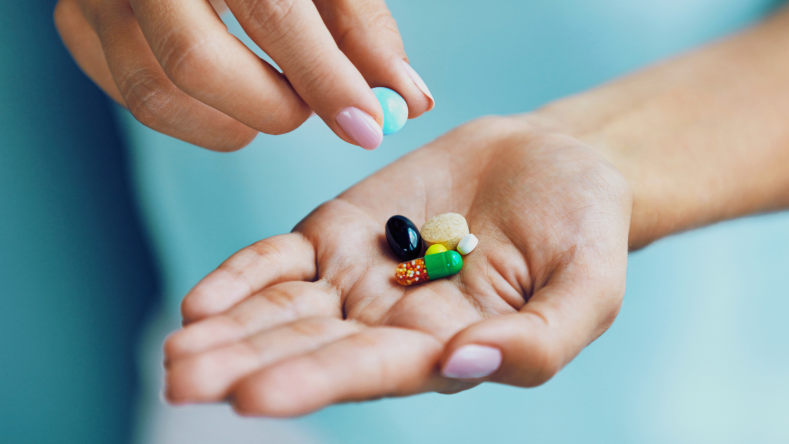Multivitamin for women: what you need to know
Multivitamins are often seen as a one-and-done approach to supplementation. But do multivitamins work, and should you add them to your daily routine? Here’s everything you need to know about women’s multivitamins.

More than one-third of American adults take a multivitamin, which makes it one of the most commonly used supplements in the United States [ 1
What are multivitamins?
Multivitamins are a type of nutrition supplement that contain a variety of different vitamins and minerals. They are often seen as a one-and-done approach to supplementation since one dose contains a mixture of micronutrients that are essential for health.
Many people seem to gravitate towards multivitamins, as they are often more convenient, readily available, and less expensive than individual supplements. Moreover, multivitamins are available in many forms (like tablets, capsules, gummies, powders, and liquids), so you can choose which one works best for you and your preferences.

Do multivitamins work?
While you can get many nutrients from a healthful, well-balanced diet, you may not get all of them on a regular basis, especially if you eat a typical Western diet.
Studies have found that only 28% of adults eat their recommended five servings of fruit and vegetables each day 2 3 4
This is where multivitamins come into play. They provide up to 100% of the daily value for many vitamins and minerals, so they can be a convenient way to bridge nutritional gaps in your diet. Multivitamins may also decrease the risk of deficiency in certain populations such as women of child-bearing age, pregnant and lactating women, children, adolescents, those who are obese, and low-income individuals [ 27 28
However, multivitamins aren’t a magic cure for health–while taking one may help meet your nutrient needs and prevent deficiencies, it won’t mitigate the other health risks that come with a poor diet.
A poor diet usually consists of refined sugars, processed foods, and trans fats, and has been linked to a risk of chronic disease, obesity, inflammation, and cancer [ 5 6 7 8
As such, multivitamins should be consumed in tandem with a nutritious diet, not in place of it.
Multivitamins may not be for everyone. If you have a specific nutrient deficiency, you should speak with your healthcare provider to determine the best course of action.
Precautions
Unlike food, supplement regulation is largely in the hands of manufacturers and FDA approval for supplements is only required when the product contains a new ingredient.
According to the FDA, every dietary supplement needs to be labeled with the term "dietary supplement" or with a term that substitutes a description of the product's dietary ingredient(s) for the word "dietary" [ 9
Furthermore, some supplements may contain ingredients that can interact with medications, so speak with your healthcare provider before starting a new supplement [ 10
Always choose a supplement that has been
third-party tested
to help to ensure purity, dosage and freshness.

What’s in a women’s multivitamin?
While anyone can benefit from supplementation, a woman’s multivitamin has varying amounts of vitamins and minerals that are essential to health, and contribute to reproduction, hormone regulation, immunity, and more [ 11
Some common nutrients found in a woman's multivitamin include:
Folate. This B vitamin is important for all women of reproductive ages, as it helps protect against major birth defects (like anencephaly and spina bifida), and keeps the blood healthy by helping red blood cells form and grow [
14
].Vitamin A. Vitamin A is important for eyesight, immunity, reproduction, and bone strength [
15
].Vitamin B6. Vitamin B6 greatly benefits brain, eye, and heart health, hemoglobin production, and immunity [
16
].Vitamin B12. Vitamin B12 is responsible for the central nervous system, formation of healthy red blood cells, and DNA synthesis [
17
]. It’s also important for reproductive purposes, as a deficiency may cause neural tube defects, developmental delays, failure to thrive, and anemia in offspring.Vitamin C. Vitamin C is important for iron absorption, immune health, wound healing, and collagen formation [
18
].Vitamin D
. Vitamin D is essential for calcium absorption and immune function, as well as bone, muscle, and heart health. Vitamin D also has important anti-inflammatory, antioxidant, and neuroprotective properties that support brain health [19
,20
].Vitamin E. Vitamin E is a powerful antioxidant that positively impacts vision, brain health, and women’s reproductive health [
21
].Vitamin K. Vitamin K helps with blood clotting and bone health [
22
].Calcium. Calcium supports bone health and is also needed for the heart, muscles, and nerves to function properly [
23
].Magnesium
. Magnesium plays many critical roles in the body, including protein synthesis, bone health, energy production, disease prevention, and heart, muscle, and nerve function [24
].Zinc. Studies show that zinc can effectively reduce inflammation, boost immune health, reduce your risk of age-related diseases, speed wound healing, and aid in reproductive health [
25
].Iron. Iron supports muscle metabolism and healthy connective tissue and is necessary for healthy pregnancies, physical growth, neurological development, cellular functioning, and synthesis of some hormones [
26
]. It’s included in most women’s vitamins due to increased losses with menstruation.
Best time to take multivitamins
The best time to take multivitamins is during a meal. Because a multivitamin contains a mixture of both fat- and water-soluble vitamins, food can help with the absorption of certain nutrients and reduce the risk of digestive issues.
Multivitamin side effects
Multivitamins are generally considered safe, but some people may experience digestive issues (like nausea, constipation, diarrhea, or an upset stomach) when starting out [ 12 13
Summary
Multivitamins are one of the most common supplements in the United States, and for good reason. Often seen as a one-and-done approach to supplementation, multivitamins tend to be more convenient, readily available, and less expensive than individual supplements.
If you’re a woman, taking a multivitamin may be beneficial since it has varying amounts of vitamins and minerals that are essential to health and contribute to reproduction, hormone regulation, immunity, and more.
However, while multivitamins can meet many nutrient needs, they won’t mitigate other health risks that come with a poor diet. As such, multivitamins should be consumed in tandem with a nutritious diet, not in place of it.
Disclaimer: The text, images, videos, and other media on this page are provided for informational purposes only and are not intended to treat, diagnose, or replace personalized medical care.
Key takeaways
Multivitamins are seen as a one-and-done approach to supplementation, since one dose contains a mixture of vitamins and minerals that are essential for health.
Multivitamins aren’t a magic cure for health. While they may help meet your nutrient needs, it won’t mitigate the other health risks that come with a poor diet.
A women’s multivitamin has varying amounts of vitamins and minerals that are essential to health, and contribute to reproduction, hormone regulation, immunity, and more [
11
].It’s best to take a multivitamin with meals, as food can help with the absorption of certain nutrients and reduce the risk of digestive issues.
References
Ronis, M., Pedersen, K. B., & Watt, J. (2018). Adverse Effects of Nutraceuticals and Dietary Supplements. Annual review of pharmacology and toxicology, 58, 583–601.
https://doi.org/10.1146/annurev-pharmtox-010617-052844
Strategies to prevent obesity and other chronic diseases-the CDC guide ... (n.d.). Retrieved August 12, 2022, from
https://www.cdc.gov/obesity/downloads/fandv_2011_web_tag508.pdf
Lalji, C., Pakrashi, D., & Smyth, R. (2018). Can eating five fruit and veg a day really keep the doctor away? Economic Modelling, 70, 320–330.
https://doi.org/10.1016/j.econmod.2017.07.024
Wallace, T. C., McBurney, M., & Fulgoni, V. L. (2014). Multivitamin/Mineral Supplement contribution to micronutrient intakes in the United States, 2007–2010. Journal of the American College of Nutrition, 33(2), 94–102.
https://doi.org/10.1080/07315724.2013.846806
Seiler, A., Chen, M. A., Brown, R. L., & Fagundes, C. P. (2018). Obesity, Dietary Factors, Nutrition, and Breast Cancer Risk. Current breast cancer reports, 10(1), 14–27.
https://doi.org/10.1007/s12609-018-0264-0
Furman, D., Campisi, J., Verdin, E., Carrera-Bastos, P., Targ, S., Franceschi, C., Ferrucci, L., Gilroy, D. W., Fasano, A., Miller, G. W., Miller, A. H., Mantovani, A., Weyand, C. M., Barzilai, N., Goronzy, J. J., Rando, T. A., Effros, R. B., Lucia, A., Kleinstreuer, N., & Slavich, G. M. (2019). Chronic inflammation in the etiology of disease across the life span. Nature Medicine, 25(12), 1822–1832.
https://doi.org/10.1038/s41591-019-0675-0
Schulze, M. B., Martínez-González, M. A., Fung, T. T., Lichtenstein, A. H., & Forouhi, N. G. (2018). Food based dietary patterns and chronic disease prevention. BMJ.
https://doi.org/10.1136/bmj.k2396
Fadnes, L. T., Økland, J.-M., Haaland, Ø. A., & Johansson, K. A. (2022). Estimating impact of food choices on life expectancy: A modeling study. PLOS Medicine, 19(2).
https://doi.org/10.1371/journal.pmed.1003889
Commissioner, O. of the. (n.d.). FDA 101: Dietary supplements. U.S. Food and Drug Administration. Retrieved August 15, 2022, from
https://www.fda.gov/consumers/consumer-updates/fda-101-dietary-supplements
Center for Food Safety and Applied Nutrition. (n.d.). Mixing Medications and Dietary Supplements Can Endanger Your Health. U.S. Food and Drug Administration. Retrieved August 12, 2022, from
https://www.fda.gov/consumers/consumer-updates/mixing-medications-and-dietary-supplements-can-endanger-your-health
U.S. National Library of Medicine. (n.d.). Minerals. MedlinePlus. Retrieved August 12, 2022, from
https://medlineplus.gov/minerals.html
Biesalski, H. K., & Tinz, J. (2017). Multivitamin/mineral supplements: Rationale and safety. Nutrition (Burbank, Los Angeles County, Calif.), 36, 60–66.
https://doi.org/10.1016/j.nut.2016.06.003
Kamangar, F., & Emadi, A. (2012). Vitamin and mineral supplements: do we really need them?. International journal of preventive medicine, 3(3), 221–226.
Centers for Disease Control and Prevention. (2022, June 15). Folic acid. Centers for Disease Control and Prevention. Retrieved August 12, 2022, from
https://www.cdc.gov/ncbddd/folicacid/about.html
U.S. Department of Health and Human Services. (n.d.). Office of dietary supplements - vitamin A and carotenoids. NIH Office of Dietary Supplements. Retrieved August 12, 2022, from
https://ods.od.nih.gov/factsheets/VitaminA-Consumer/
U.S. Department of Health and Human Services. (n.d.). Office of dietary supplements - vitamin B6. NIH Office of Dietary Supplements. Retrieved August 12, 2022, from
https://ods.od.nih.gov/factsheets/VitaminB6-HealthProfessional/
U.S. Department of Health and Human Services. (n.d.). Office of dietary supplements - vitamin B12. NIH Office of Dietary Supplements. Retrieved August 12, 2022, from
https://ods.od.nih.gov/factsheets/VitaminB12-HealthProfessional/
U.S. National Library of Medicine. (n.d.). Vitamin C: Medlineplus medical encyclopedia. MedlinePlus. Retrieved August 12, 2022, from
https://medlineplus.gov/ency/article/002404.htm
Mayo Foundation for Medical Education and Research. (2021, February 9). Vitamin D. Mayo Clinic. Retrieved August 12, 2022, from
https://www.mayoclinic.org/drugs-supplements-vitamin-d/art-20363792
U.S. Department of Health and Human Services. (n.d.). Office of dietary supplements - vitamin D. NIH Office of Dietary Supplements. Retrieved August 12, 2022, from
https://ods.od.nih.gov/factsheets/vitamind-healthprofessional/
Mohd Mutalip, S. S., Ab-Rahim, S., & Rajikin, M. H. (2018). Vitamin E as an Antioxidant in Female Reproductive Health. Antioxidants (Basel, Switzerland), 7(2), 22.
https://doi.org/10.3390/antiox7020022
DiNicolantonio, J. J., Bhutani, J., & O'Keefe, J. H. (2015). The health benefits of vitamin K. Open heart, 2(1), e000300.
https://doi.org/10.1136/openhrt-2015-000300
U.S. Department of Health and Human Services. (n.d.). Calcium and vitamin D: Important at every age. National Institutes of Health. Retrieved August 12, 2022, from
https://www.bones.nih.gov/health-info/bone/bone-health/nutrition/calcium-and-vitamin-d-important-every-age
Volpe, S. L. (2013). Magnesium in disease prevention and overall health. Advances in Nutrition, 4(3).
https://doi.org/10.3945/an.112.003483
Nasiadek, M., Stragierowicz, J., Klimczak, M., & Kilanowicz, A. (2020). The Role of Zinc in Selected Female Reproductive System Disorders. Nutrients, 12(8), 2464.
https://doi.org/10.3390/nu12082464
U.S. Department of Health and Human Services. (n.d.). Office of dietary supplements - iron. NIH Office of Dietary Supplements. Retrieved August 12, 2022, from
https://ods.od.nih.gov/factsheets/Iron-HealthProfessional/
Bruins, M. J., Bird, J. K., Aebischer, C. P., & Eggersdorfer, M. (2018). Considerations for Secondary Prevention of Nutritional Deficiencies in High-Risk Groups in High-Income Countries. Nutrients, 10(1), 47.
https://doi.org/10.3390/nu10010047
U.S. Department of Health and Human Services. (n.d.). Office of dietary supplements - multivitamin/mineral supplements. NIH Office of Dietary Supplements. Retrieved August 23, 2022, from
https://ods.od.nih.gov/factsheets/MVMS-HealthProfessional/







